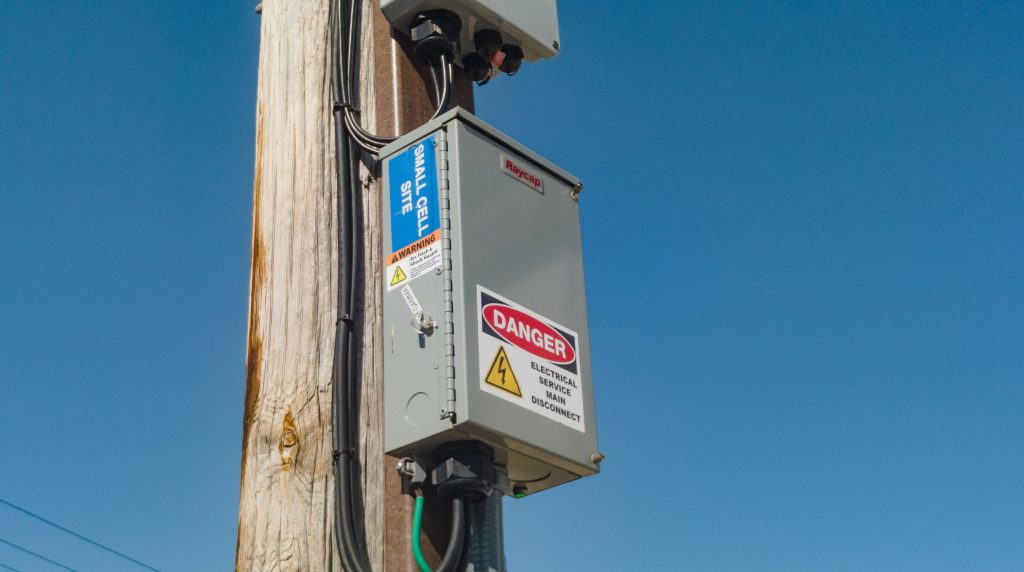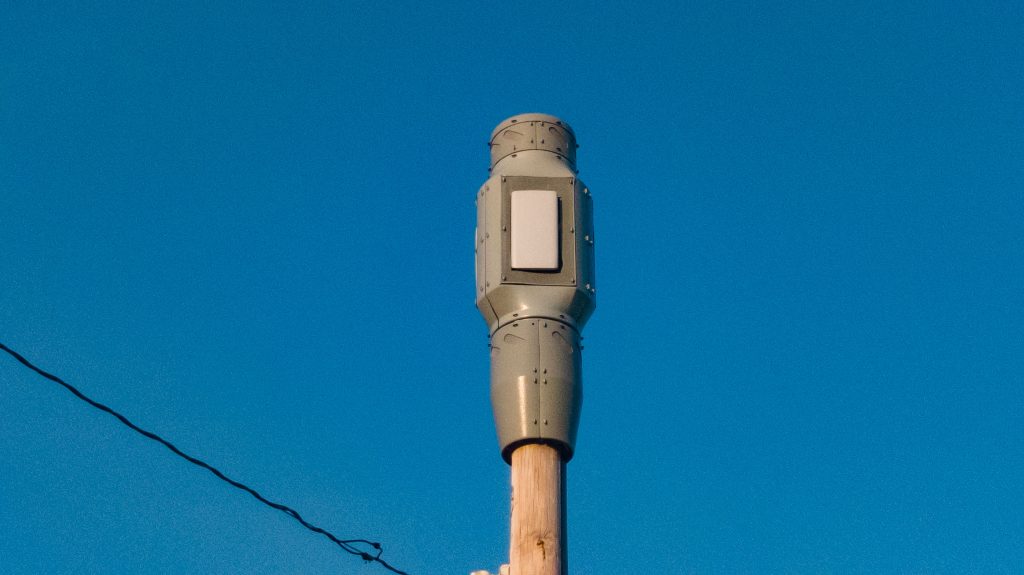
A small 5G wireless facility on top of an existing timber pole, Lavallette, N.J., May 2023. (Photo: Shorebeat)
The Lavallette planning board on Wednesday night voted to recommend the denial of permits for Verizon to build six more “small cell” wireless antenna nodes in town, with the borough administrator – who serves on the board – issuing a strong rebuke of the wireless company’s plan to seemingly blanket Lavallette with more such equipment than any neighboring town.
The final decision on permits for the six new antennas, which would bring the total number of small cell nodes in Lavallette to 16, rests with the borough council. At a future meeting, the council will review the recommendation and resolution promulgated by the board and take their own vote on the issuance. If the council agrees with the board and denies the permits, it is likely that a legal battle will ensue similar to that which is ongoing in Belmar, where the council has hired attorneys to fight a plan by Verizon to install 20 poles along the borough’s boardwalk.
A radiofrequency engineer hired by Verizon previously explained that the legacy wireless company operates on frequencies that require the “small cell” network for reliable 5G – and 4G – coverage and bandwidth, while some other operators purchased wide swaths of RF spectrum on frequencies that are more optimized for antennas on top of large structures, such as dedicated communications towers or water towers. An attorney for Verizon reiterated to the board Wednesday that federal law provides limited regulatory powers to municipal governments when it comes to wireless infrastructure.
The six locations where Verizon proposed its antennas – some on existing poles and some on new poles – were:
- 72 Oceanfront (revised)
- 2 President (revised)
- 122 Newark Ave. (new plan)
- 100 Oceanfront (revised)
- 110 White Ave. (revised)
- 506 Oceanfront (revised)
Some of the antennas were to be installed on existing utility poles owned by the municipal electric utility while others were to be placed on newly-built poles since the existing poles were leaning. Some board members, as well as the board engineer, voiced concern that placing heavy 4G and 5G equipment on existing poles near the ocean where they would be exposed to high winds could create a hazard. Another one of the poles could conceivably block wheelchair access to a beach entrance.
Verizon’s representatives said they reviewed the integrity of the poles and determined that, even though some were leaning, they did not need to be replaced before equipment was hung on them.
“You’re going to now add something with a lot of weight and a lot of size, and you’re telling me that’s not going to affect it?” asked board member Joanne Filippone, who also serves on the borough council.
A Verizon engineer testified that the poles would host both 4G and 5G nodes, adding more than 400 pounds of equipment to the poles, including 322 pounds at the top between the antenna and its housing structure. The radio cabinets themselves, where 4G equipment is located, weighs 435 pounds and would be placed on the side of the pole rather than on the top.

A small 5G wireless facility on top of an existing timber pole, Lavallette, N.J., May 2023. (Photo: Shorebeat)
The meeting was attended by about a dozen residents, a few of whom entered comments into the record. None supported the application.
“It is bad enough we are exposed to what is already out there,” said Barbara Susinno. “Placing gigantic equipment in our town is just plain gross.”
Borough Administrator John O. Bennett took issue with the number of antenna arrays Verizon has proposed for Lavallette, telling the wireless company’s representatives that officials surveyed other municipal leaders and none received as many applications for such antennas as Lavallette. In many cases, there were no previous or pending applications for such small cell networks.
“I’ve yet to hear a reason why six additional poles are necessary,” said Bennett, an attorney who formerly served in the state legislature and as acting governor. “I think it is absurd that there are 16 antennas proposed for this town and there are two on the rest of the barrier island. Do we have a different kind of seagull, or something, that blocks the signal?”
“There has not been any showing of a requirement of need, and it goes against the planning of the town of Lavallette, the master plan and the zoning ordinance,” he continued, recommending the board vote ‘no’ on the recommendation.
Bennett’s comments were echoed by resident Alexander Barletta, who said he served on the planning board in his former town in North Jersey.
“Every time Verizon or another carrier came to us, they would come with a map of the town and show us the towers or nodes,” he said. “Now that we find out that we’re the only town on the barrier island with all these poles, I began thinking the same thing – why Lavallette?”
Edward W. Purcell, the attorney representing Verizon, said additional nodes have been applied-for in other Shore towns, though he did not reference the controversial Belmar proposal. Purcell also implied that the borough would be overstepping its jurisdictional bounds by failing to approve the antennas as long as they complied with federal regulations and the language of the borough’s zoning ordinance at the time the application was filed. The borough has since updated that ordinance.
The board unanimously voted to recommend the borough council deny all six of the applications when the matter comes before that body. Lavallette’s borough council meets Nov. 13, though it was not announced when, exactly, the council would vote on a final decision.

Advertisement

Police, Fire & Courts
Driver, 21, Pleads Guilty in Fatal Pedestrian Crash on Route 35

Police, Fire & Courts
Police Investigating Possible Shots Fired in Seaside Heights

Police, Fire & Courts
Cops: Juvenile Arrested After 118mph Joy Ride in Seaside Heights, Toms River Kills 2

Seaside Heights & Seaside Park
Seaside Heights Mourns Passing of Boardwalk Legend, Still Working Into His 90s

Police, Fire & Courts
Vehicle Careens Off Route 37 Causeway, Driver Gets Multiple Summonses

Ortley Beach & North Beaches
Ortley Beach $5M ‘Makeover’ Of Streetscapes, Boardwalk, Parking Ready for Bidding






